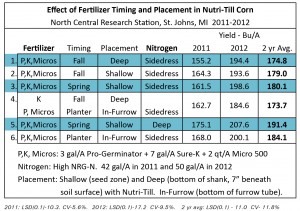Strip-till applications are the perfect time to place liquid fertility where the crop needs it, with the assurance that nutrients will be available when and where you need them.
Strip-till combines the best features of no-till and conventional tillage systems. Tilled strips that will house the seed row reside alongside undisturbed bands of crop residue that shelter the soil and conserve moisture. Growers who want to practice Responsible Nutrient Management, have poorly drained soils or are apprehensive about areas with poor soil structure can benefit from using strip-till in their operations.
Strip-till accelerates the warming and drying of the soil in the spring, which stimulates earlier and deeper root growth in field crops such as corn. It can also increase air circulation and improve aerobic conditions.
One of the biggest advantages of strip-till is that nutrients can be placed into the root zone where there is less potential they will be diverted or immobilized by crop residue. Dual placement of phosphorus (P), potassium (K) and micronutrients near the seed zone and placement of nitrogen beneath the seed zone, improves the proximity of nutrients to the roots as they grow and develop.
Successful strip-till applications match the right nutrients with the right timing, according to geographic area. For example, it isn’t advisable to apply nitrogen in the fall in areas that have large amounts of rainfall because of the potential for leaching. However, in arid areas growers can successfully apply nitrogen in the fall.
An effective combination for strip-till applications is Pro-Germinator for phosphorus and Sure-K for potassium, along with microLink for balanced micronutrient application. For nitrogen applications, AgroLiquid offers a number of choices from their N-Suite to meet the needs of any strip-till situation.
Agronomists at the North Central Research Station in St. Johns, Mich., conducted a two-year trial that assessed the effect of fertilizer timing and placement on strip-till corn (2012 Research Report, Effect of Fertilizer Timing and Nutrient Placement in Nutri-Till/Strip-Till Corn).
 Researchers found that deep fall placement was only slightly lower in yield than shallow fall placement. And both spring and fall placement of P, K and micronutrients resulted in similar yields. The study also established that the highest yield for both years was where all of the fertilizer was applied in the spring with the strip-till operation. This treatment resulted in corn that was noticeably ahead of the other treatments.
Researchers found that deep fall placement was only slightly lower in yield than shallow fall placement. And both spring and fall placement of P, K and micronutrients resulted in similar yields. The study also established that the highest yield for both years was where all of the fertilizer was applied in the spring with the strip-till operation. This treatment resulted in corn that was noticeably ahead of the other treatments.
Growers are often apprehensive about nutrient applications during fall strip-till because they worry nutrients will not be available for crops the next year. AgroLiquid product formulations promote stability and protect nutrients from tie-up and loss. They are a great fit for conservation tillage cropping systems. Best of all, growers can apply fertilizer with confidence during strip-till, having the peace of mind that nutrients will be available at the right time and in the right place.
###


I will like to know how this works on hay fields, an how much to apply ?
Hi Darryl,
Normally strip till applications on hay crops are done over the surface in bands. Growers can apply bands from 10 inches apart up to 30 inches apart to supply nutrients to the crop. With the applications being in a band most growers see better nutrient availability due to less tie-up compared to a broadcast application. The only concern would be a grower would not be able to apply crop protection products in this manner.
As far as rates per acre, Agro-Culture Liquid recommends looking at crop nutrient needs, along with yield goals, then look at the soil analysis to determine what can be applied to increase nutrient efficiency and availability.
While reading the recent posting of the nutrient placement with the conservation tillage system of Strip-Tillage I thought, wow I could not have said it better for what I have observed over the last 7 seasons. We have nearly eliminated leaching losses with spring strip-till operations in the Western Corn Belt. With liquid fertility programs our phosphorus, potassium, sulfur, zinc and micros are all in the root pathway. A plant can and will thrive until the harvester gets to the field. We at the Orthman Research Farm in south central Nebraska agree all the features of nutrient placement using the right product in the right place, right timing, using high quality products give us right results. Broadcast fertilizing is much akin to lighting fire to that good stuff the residue and waiting for no wind to come up. Not the best use of input dollars! Besides, do roots grow on the surface?
How deep is deep placement? Also when considering the LSD and CV, aren’t all these yields equal?